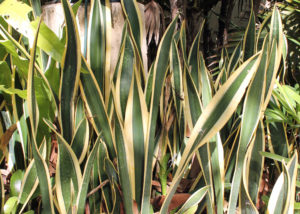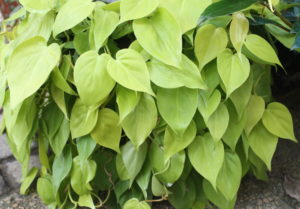10 Houseplants You’re Unlikely to Kill
February 5th, 2019
Before you beat yourself up too much over killing houseplants, realize that no plant is native to the inside of a house.
It’s a tall order to ask any plant to grow well in the sunlight-challenged and dry air of a typical central-Pennsylvania house, especially in winter.
However, a fair number of plants are up to the challenge. For your winter-sanity consideration, I thought I’d list 10 of the toughest houseplants that also are interesting and/or useful enough to brighten your February housescaping. Just don’t overwater them…
1.) ZZ plant (Zamioculcas zamiifolia). I’ve seen this one survive being stuck in a dark corner and ignored for a month or more.
ZZ plants have succulent, glossy green leaves that are arranged opposite one another on the stems, giving it a ladder or stairs-like feel. It’ll grow upright slowly 2 to 3 feet or so.
2.) Chinese evergreen (Aglaonema). Yeah, it’s a plain-Jane foliage plant, but it does give some bright color in its striped silvery-white and green variegated leaves.
It’ll also take low light and much neglect.
3.) Cast iron plant (Aspidistra elatior). The name ought to tell you something about this 2-foot foliage plant that looks a bit like a bushy corn plant. It laughs off very low light, irregular watering, dry air, near-freezing temperatures, dust, coffee dregs… you name it.
Cast iron plants have dark-green, shiny, leathery leaves. ‘Milky Way’ is a compact version with white speckles.
4.) Snake plant (Sansevieria). Snake plants grow in upright clusters of bladed, strappy leaves, most often sold in variegated gold and green. But you’ll also find dark-green varieties and an interesting version with hollow, tubular stems.
Tolerates low light and neglect nicely.
5.) Peace lily (Spathiphyllum). One of the most popular houseplants, peace lilies are the dense, bushy plants that put out those hooded, cobra-like white flowers.
They tolerate low light and a wide range of conditions, although in low enough light, they probably won’t rebloom. Even then, though, the foliage is lush and very adept at purifying indoor air.
6.) Lucky bamboo (Dracaena sanderiana). Not a true bamboo, these are pinky-sized canes that send out strappy green leaves when stuck in water. Lucky bamboo will grow in sand or pebble trays – no soil needed.
They’re typically sold bundled and trained in Zen-like arrangements. Legend has it that they bring good luck… a great side benefit when you’re about to look at the weather forecast.
7.) Ponytail palm (Beaucarnea recurvata). Technically not a palm at all (it’s a Mexican-desert lily relative), this plant looks like a little tree with a balled base, a bare trunk and what looks like a head pulled up into a leafy green ponytail.
Kids and teens should especially like this one. It’s a houseplant with an attitude. And it’s slow-growing, low-care, and unlikely to die so long as you don’t overwater it.
8.) Sago palm (Cycas revoluta). Another palm that’s not a true palm, sago palm is a cycad that’s been around since before the dinosaurs. It’s very compact and slow-growing and sprouts green umbrellas of cut leaves from a central barrel-shaped trunk.
If this plant managed to survive brontosaurus browsing, it’s a good bet to cope with your living room.
9.) Heart-leaf philodendron (Philodendron cordatum). Here’s a vining foliage plant with heart-shaped leaves, best grown in a hanging planter or elevated pot so the vines can drape down.
Heart-leaf philodendrons actually prefer lower light and soil that’s on the dry side. Their main demand is occasional snipping.
10.) Golden pothos (Epipremnum aureum). Another vine, this one has heart-shaped leaves of gold and green.
Tolerant of poor and abusive lighting, golden pothos trails nicely from a basket or can be trained up a trellis in a pot for a mini-tree effect.
Need still more to feed your hibernation fancy? Here are eight more houseplants that are among the toughest:
Dracaena ‘Janet Craig’ (Dracaena deremensis)
Jade plant (Crassula argentea)
Prayer plant (Maranta leuconeura var. erythroneura)
Rubber plant (Ficus elastica)
Boston fern (Nephrolepis exaltata)
English ivy (Hedera helix)
Kentia palm (Howea fosteriana)
Umbrella plant (Cyperus alternifolius)











